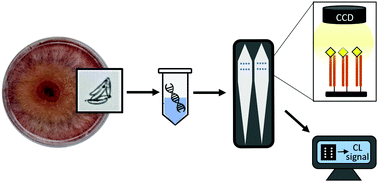A chemiluminescence-based heterogeneous asymmetric recombinase polymerase amplification assay for the molecular detection of mycotoxin producers†
Abstract
The analysis of mold in indoor air is a prominent topic but it is hardly dealt with. The most affected fields of this issue are residential- and occupational safety since mold can have a number of impacts on human health. To date the most used methods for quantification of microorganism contamination in indoor air are culture- or microscopy-based and are not capable of translating the on-site situation to analytical data reliably. Here we present a chemiluminescence-based method to detect mycotoxin producers through isothermal amplification of mycotoxin biosynthesis genes using glass and polycarbonate carriers. In this proof-of-principle study, zearalenone producers were aimed to be detected by heterogeneous asymmetric recombinase polymerase amplification (haRPA). For this, an appropriate lysis method for fungal spores was developed allowing rapid access to DNA. A system calibration with spores of Fusarium culmorum as zearalenone-producing organism resulted in an LOD of 2.7 × 105 spores per ml. The system was shown to be specific for zearalenone producers. This work presents the first application of a heterogeneous isothermal amplification for rapid detection and quantification of mycotoxin producers. In the future, a multiplex detection can be possible by haRPA.



 Please wait while we load your content...
Please wait while we load your content...